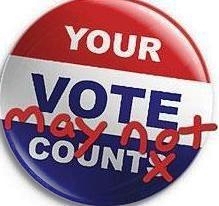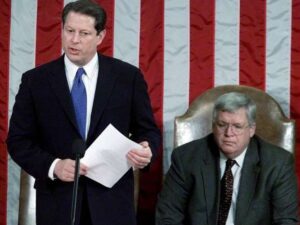Archive for August 21st, 2020
» posted on Friday, August 21st, 2020 by Linda Lou Burton
Who Counts?
 Linda Lou Burton posting from Little Rock, Arkansas – Interesting, isn’t it, that women fought so long and hard to be allowed to vote, but still must live in the right state for their vote to count. That’s true for men too! If you favor a Democrat, but live in a state full of Republicans, your vote isn’t worth the paper it’s printed on. And vice versa. In fact, you don’t actually vote for a CANDIDATE at all, though political campaigns are designed to appeal directly to the individual, coddling us with love and promises, if we vote for THEM.
Linda Lou Burton posting from Little Rock, Arkansas – Interesting, isn’t it, that women fought so long and hard to be allowed to vote, but still must live in the right state for their vote to count. That’s true for men too! If you favor a Democrat, but live in a state full of Republicans, your vote isn’t worth the paper it’s printed on. And vice versa. In fact, you don’t actually vote for a CANDIDATE at all, though political campaigns are designed to appeal directly to the individual, coddling us with love and promises, if we vote for THEM.
Once our vote is cast, however, it actually starts a ride through the maze known as the Electoral College, and if you recollect, five times since 1788 a candidate has won the popular vote but lost the election.
- Andrew Jackson in 1824 had 38,149 more votes than John Quincy Adams, but lost.
- Samuel Tilden (Dem) in 1876 had 254,235 more votes than Rutherford B Hayes (Rep), but lost.
- Grover Cleveland (Dem) in 1888 had 90,596 more votes than Benjamin Harrison (Rep), but lost.
- Al Gore (Dem) in 2000 had 543,895 more votes than George W Bush (Rep), but lost.
- Hillary Clinton (Dem) in 2016 had 2,868,686 more votes than Donald J Trump (Rep), but lost.
I’m sure you’ve got this memorized from Civics 101 in 6th grade, but just in case the details have gotten fuzzy, here is where your vote goes. Established in Article II, Section 1 of the US Constitution, the Electoral College is the formal body that elects the President and Vice President of the United States. Each state has as many “electors” in the Electoral College as it has Representatives and Senators in the United States Congress, and the District of Columbia has three electors. When voters go to the polls in a Presidential election, they actually are voting for the slate of electors vowing to cast their ballots for that ticket in the Electoral College.
Got that? You are voting for Electors.
Most states require that all electoral votes go to the candidate who receives the plurality in that state. After state election officials certify the popular vote of each state, the winning slate of electors meet in the state capital and cast two ballots—one for Vice President and one for President. Electors cannot vote for a Presidential and Vice Presidential candidate who both hail from an elector’s home state.
But not every state is the same.
Maine and Nebraska employ a “district system” in which two at-large electors vote for the state’s popular plurality and one elector votes for each congressional district’s popular plurality. In the November 2, 2004 election, Colorado voters rejected a “proportional system” in which electors would vote proportionally based on the state’s popular vote.
The District of Columbia and 26 states “bind” their electors to vote for their promised candidate, via a number of methods including oaths and fines. Though still rare, electors more commonly changed their vote in the 19th century—particularly on the vote for Vice President. Such “faithless electors” have never decided a Presidency however.
There has been one faithless elector in each of the following elections: 1948, 1956, 1960, 1968, 1972, 1976, and 1988. A blank ballot was cast in 2000. In 2016, seven electors broke with their state on the presidential ballot and six did so on the vice presidential ballot.
Faithless Electors! But to continue – A Job You Wouldn’t Want
Since the mid-20th century, on January 6 at 1:00 pm before a Joint Session of Congress, the Vice President opens the votes from each state in alphabetical order. He passes the votes to four tellers—two from the House and two from the Senate—who announce the results. House tellers include one Representative from each party and are appointed by the Speaker. At the  end of the count, the Vice President then declares the name of the next President. With the ratification of the 20th Amendment to the Constitution (and starting with the 75th Congress in 1937), the electoral votes are counted before the newly sworn-in Congress, elected the previous November. Sitting Vice Presidents John C. Breckinridge (1861), Richard Nixon (1961), Hubert Humphrey (1969), and Al Gore (2001) all had to announce that they had lost their own bid for the Presidency. https://history.house.gov/
end of the count, the Vice President then declares the name of the next President. With the ratification of the 20th Amendment to the Constitution (and starting with the 75th Congress in 1937), the electoral votes are counted before the newly sworn-in Congress, elected the previous November. Sitting Vice Presidents John C. Breckinridge (1861), Richard Nixon (1961), Hubert Humphrey (1969), and Al Gore (2001) all had to announce that they had lost their own bid for the Presidency. https://history.house.gov/
There have been a total of 165 instances of elector faithlessness as of 2016. The United States Constitution does not specify a notion of pledging; no federal law or constitutional statute binds an elector’s vote to anything. All pledging laws originate at the state level. In 2020, the Supreme Court ruled in Chiafalo v. Washington that states are free to enforce laws that bind electors to voting for the winner of the popular vote in their state.
Supporters of the Electoral College argue that it is fundamental to American federalism, that it requires candidates to appeal to voters outside large cities, increases the political influence of small states, preserves the two-party system, and makes the electoral outcome appear more legitimate.
Non-supporters would argue that the Electoral College places powers governing a national election within state boundaries and removes the ability of the individual to select their leader.

